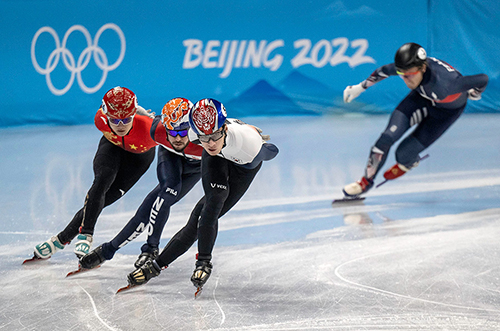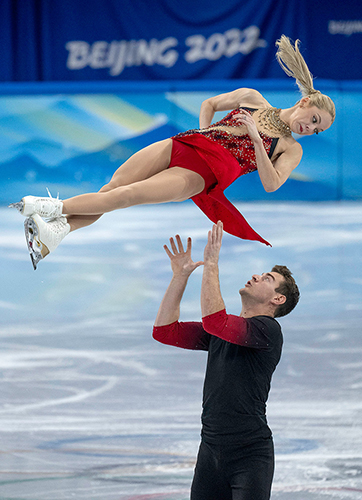

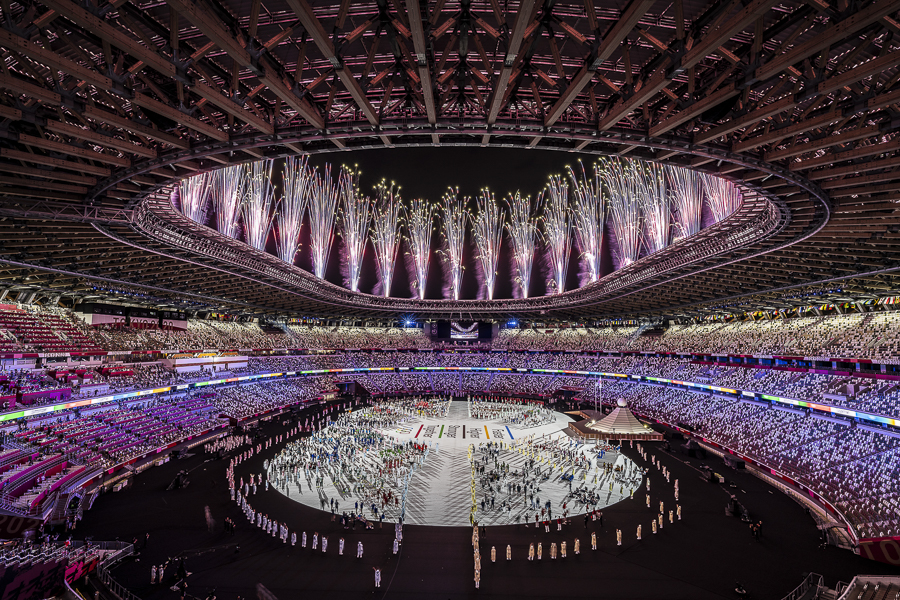 TOKYO 2020 オリンピックの開会式(2021年7月23日) ©Mark Edward Harris
TOKYO 2020 オリンピックの開会式(2021年7月23日) ©Mark Edward Harris
コロナ禍による緊急事態宣言下の開催となった TOKYO 2020 オリンピック・パラリンピック。オリンピックの開会式では6万8千人収容可能な国立競技場に観客の姿はなく、大会関係者約900人のみ。米国の写真家、マーク・エドワード・ハリス氏は、アリーナの選手たちと会場が一体化した一瞬を見逃さなかった。
今回の「表現者たち」は、スタジオから地球の極地までを撮影フィールドとする米国の写真家、マーク・エドワード・ハリス氏の世界を紹介します。
各界著名人のポートレートや、環境の変化にさらされる生き物たち、人と大自然の一体感を表現した作品が目を引きます。地政学的な見地から、各国との交流が少ない北朝鮮やイランにも足を運び人々の日常を記録しています。 若いころから日本文化に魅了され、日本の温泉の神秘さをテーマに取材したフォトエッセイは、外国人ならでは着眼点とユーモアを感じさせます。新型コロナウイルス感染の拡大するなかで開催されたTOKYO 2020 オリンピック・パラリンピックの取材は、米国『Newsweek』誌に6ページの特集記事として、写真と文章が掲載されました。 ハリス氏のインスタグラムやウェブサイトの作品=記事の最後に記載のURL=もぜひご覧ください。
(企画・コーディネート・翻訳 増田雄彦、 協力・石井真弓、佐藤仁重、中村惠美)
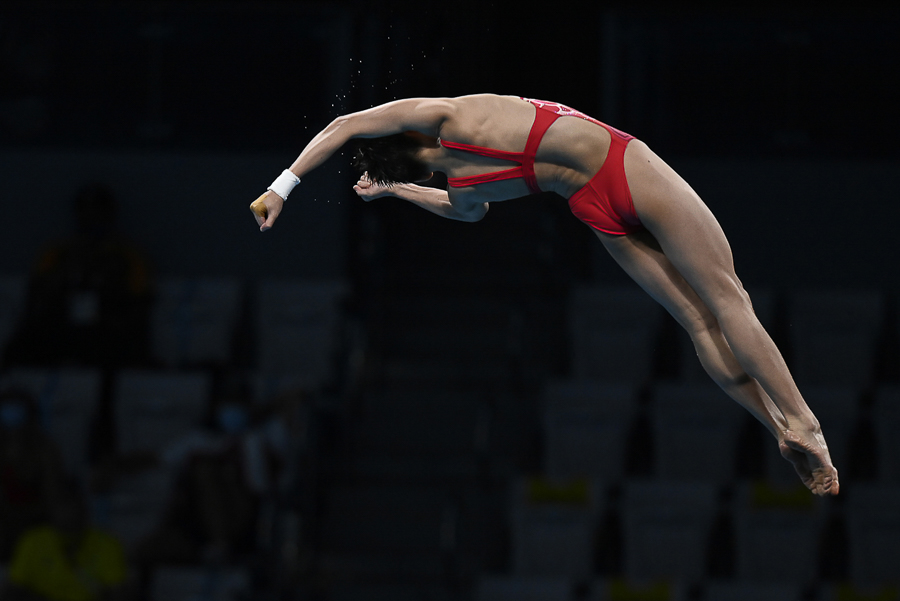 TOKYO 2020 オリンピック 中国最年少14歳の飛び込み選手、全紅嬋。女子高飛び込みで金メダルを獲得した(2021年8月5日) ©Mark Edward Harris
TOKYO 2020 オリンピック 中国最年少14歳の飛び込み選手、全紅嬋。女子高飛び込みで金メダルを獲得した(2021年8月5日) ©Mark Edward Harris
Quan Hongchan, 14-year-old Olympic diver and China’s youngest athlete at the TOKYO 2020 Olympics, won a gold medal in the women’s 10-meter platform diving competition on August 5. ©Mark Edward Harris
TOKYO 2020 – 魅了された高飛び込み
Q: オリンピック・パラリンピックの取材について、競技、会場、機材など、何を重視し、どのように選択されましたか? また、苦労した点はありますか、そしてそれをどのように解決しましたか?
Q: Regarding photo shooting of TOKYO 2020 Olympics and Paralympic games, what was important to you and how did you select the games, venues and gears? Also is there anything that was the challenge and how did you solve them?
マーク・エドワード・ハリス(以下 MEH) 私にとって初めてのオリンピック・パラリンピック取材となりました。地球上で最も好きな国である日本の特別な側面を撮影できると思い、この仕事のオファーを受けました。今まで、私が日本で撮影したフォトエッセイに「The Way of the Japanese Bath」、 「3.11」、「The Nakasendo」などがあります。オリンピック・パラリンピックでは、通常のスポーツ撮影とは異なり、可能な限り競技会場の雰囲気を伝えたいと思いました。そのため、オリンピックまたはパラリンピックのロゴを画角に入れることが多かったですね。
Mark Edward Harris (referred to as MEH): These were my first Olympic Games to cover. I particularly sought out an assignment so I could photograph another aspect of Japan, my favorite country on the planet. My other photo essays in Japan include The Way of the Japanese Bath, 3.11, and The Nakasendo. For the Olympics and Paralympics I wanted to give a sense of place whenever possible rather than just shooting sports that could be anywhere. Therefore I often tried to incorporate signage.
MEH: パンデミックの影響で、体調の報告や会場の取材予約などのすべてをアプリまたはシステムを通して行わなければならず、使いこなすまでに時間がかかりましたが、慣れてしまえばすべてがスムーズに行えるようになりました。 さまざまな競技を取材したかったので、1日に3つの会場に足を運んだこともありました。中でも10m高飛び込みは、写真的にとても魅力的な競技でした。
MEH: Because of the pandemic, it took some time to figure out all the apps we had to use to report our health condition and booking venues. Once I got that up and running everything ran smoothly. I wanted to cover the vast variety of sports so on some days I went to three venues to capture the action. Certain ones I found particularly fascinating from a photographic standpoint with the 10-meter diving being at the top of the list.
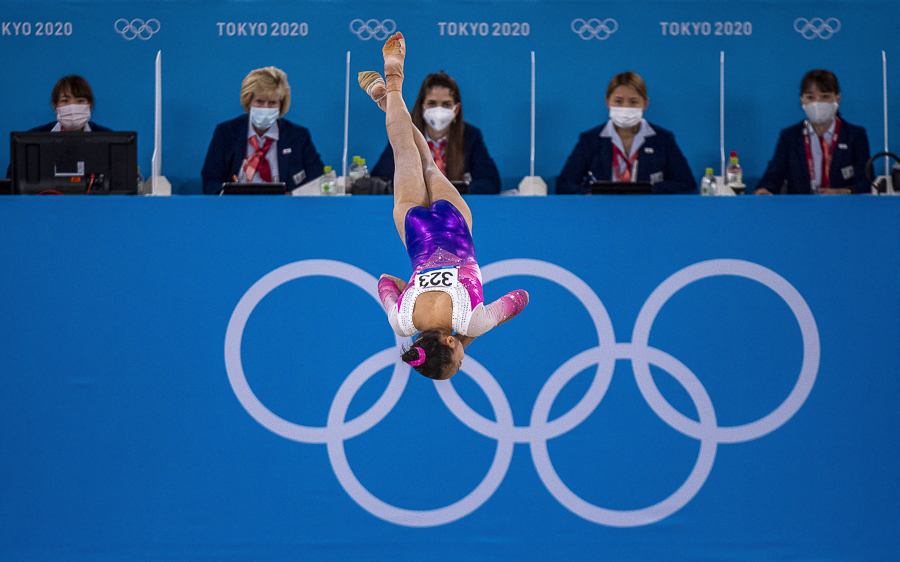 体操競技の女子個人総合決勝。審判の前で床の演技をする中国チームの唐茜靖選手(2021年7月30日) ©Mark Edward Harris
体操競技の女子個人総合決勝。審判の前で床の演技をする中国チームの唐茜靖選手(2021年7月30日) ©Mark Edward Harris
Tang Xijing of Team China performing a floor routine in front of judges on July 30 during the women’s individual all-around gymnastics final. ©Mark Edward Harris
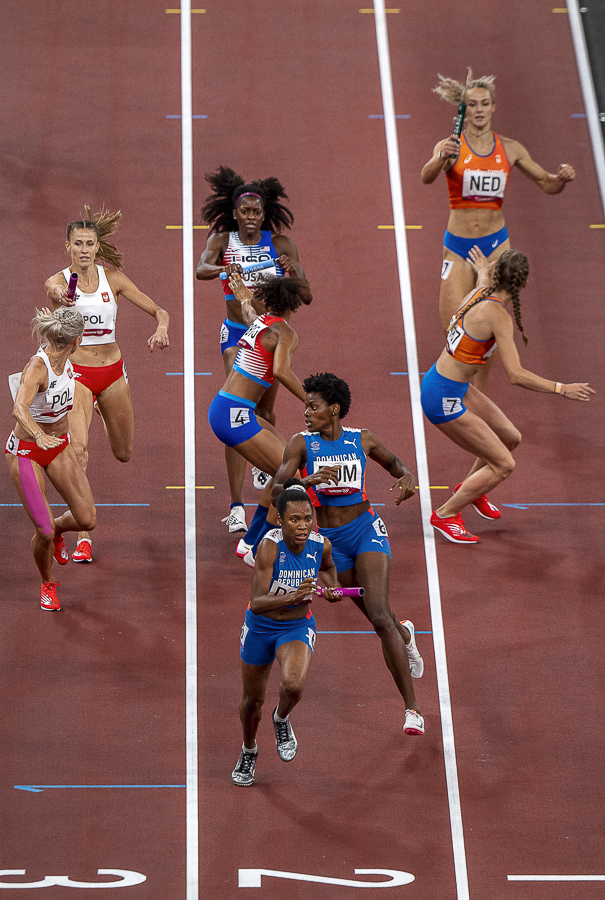 7月31日に行われた東京オリンピックの4×400メートルリレー。バトンの受け渡しの激しさが伝わってきた。 ©Mark Edward Harris
7月31日に行われた東京オリンピックの4×400メートルリレー。バトンの受け渡しの激しさが伝わってきた。 ©Mark Edward Harris
The intensity of the baton handoff was on display during the 4 × 400-meters relay at the TOKYO 2020 Olympics on July 31. ©Mark Edward Harris
TOKYO 2020 パラリンピック – 選手が直面する苦悩を表現
MEH:パラリンピックでは数人のアスリートに焦点を当て、彼らがアスリートとして TOKYO 2020にたどり着くまでに直面した精神的、肉体的な苦悩を表現したいと思いました。『Newsweek』誌の見開き6ページに掲載された記事には、暴力の犠牲になって手足を失ったり、車椅子に乗ることになったりした3人のアメリカ人アスリートについて書いたものがあります。
私がパラリンピックに興味を持ったのは、父が重度の小児麻痺を患っていたためかもしれません。それでも父の豊かな人生に大きな影響はありませんでした。
今回の取材では無観客のスタジアムやアリーナを写さないようにすることが一つの課題でした。望遠レンズと浅い被写界深度によって、この問題は解決されました。もちろん、大会の現実も表現したかったので、時には広角レンズで被写界深度を深く撮影し、観客のいない会場を表現することもありました。
MEH: For the Paralympics I was more interested in focusing in on a couple of athletes and the mental and physical struggles they faced to get to Tokyo as an athlete. One story which ran as a six page spread in Newsweek magazine was on three American athletes that were victims of violence that left them without limbs or in wheelchairs.
Part of my interest in the Paralympics might be from having a father who had a severe case of polio but it never stopped him from having a rich productive life.
One challenge was to not always show an empty stadium or arena. Long lenses and shallow depths of field resolved that issue. I of course also wanted to show the reality of the Games and would on occasion shoot a wider shot with more depth of field to show the venues void of fans.
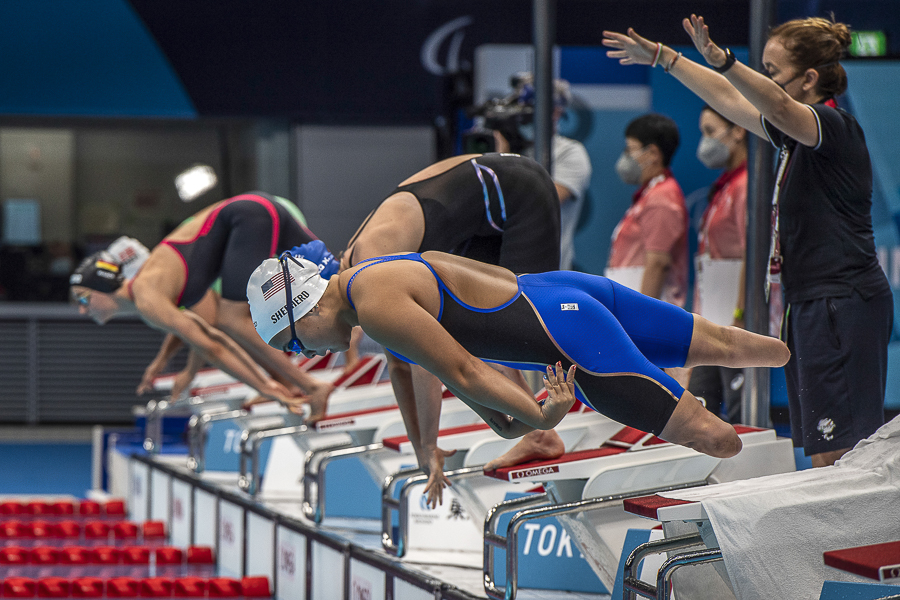 パラハリンピックの女子200メートル個人メドレー予選で、プールに飛び込む米国のヘイブン・シェパード 選手 ©Mark Edward Harris
パラハリンピックの女子200メートル個人メドレー予選で、プールに飛び込む米国のヘイブン・シェパード 選手 ©Mark Edward Harris
Team USA swimmer Haven Shepherd takes to the air at the women’s 200m individual medley heat August 28, 2021 during the TOKYO 2020 Paralympic Games. ©Mark Edward Harris
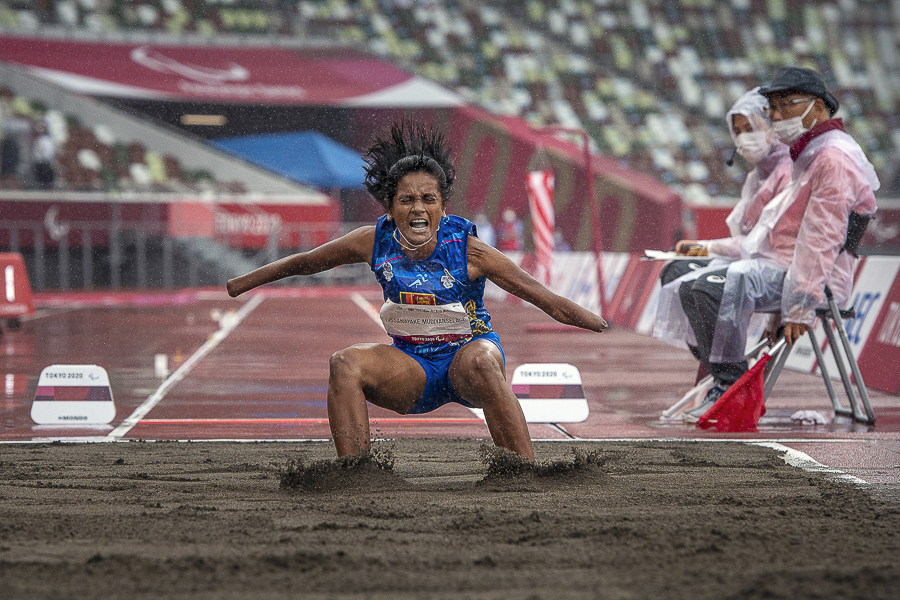 スリランカのパラリンピック・アスリート、プレマダサ・ディサケナヤケの走り幅跳びの跳躍。16歳の時に手元で手榴弾が爆発。両手と片方の目の視力を失った。TOKYO 2020では4.92mの自己ベストを更新 ©Mark Edward Harris
スリランカのパラリンピック・アスリート、プレマダサ・ディサケナヤケの走り幅跳びの跳躍。16歳の時に手元で手榴弾が爆発。両手と片方の目の視力を失った。TOKYO 2020では4.92mの自己ベストを更新 ©Mark Edward Harris
Sri Lankan Paralympic athlete Premadasa Dissanayake, who lost her hands and the vision in one eye after a hand grenade exploded in her hands when she was age 16, set a personal best of 4.92m in the long jump at TOKYO 2020. ©Mark Edward Harris
ありのままの「日常生活」を記録する
Q: あなたの写真を最も象徴するテーマは何でしょうか?
Q: What’s the theme that stands for your photography most?
MEH: 「日常生活」です。史実的な記録という意味も含めて、人間の姿を可能な限り現実に近い形で見せていきたいと思っています。ハリウッド・セレブからオリンピックの大技、 3.11のような災害まで撮ってきましたが、北朝鮮やイランなどの都会から外れた場所で、 精一杯生きている人々の物語も伝えていきたいと考えています。このような場所は、人里離れた場所にあるため、外部から十分に周知されていないことが多いのです。
MEH: I would say “daily life.” I would like to show the human condition as close to reality as possible, in part as a historical record. While I have photographed everything from Hollywood celebrities to incredible athletic feats during the Olympics and disasters such as 3.11, I also want to tell the stories of people in places out of the mainstream that are just going about their lives to the best of their abilities in places such as North Korea and Iran. These places are off the beaten path are often not understood well enough by the outside world.
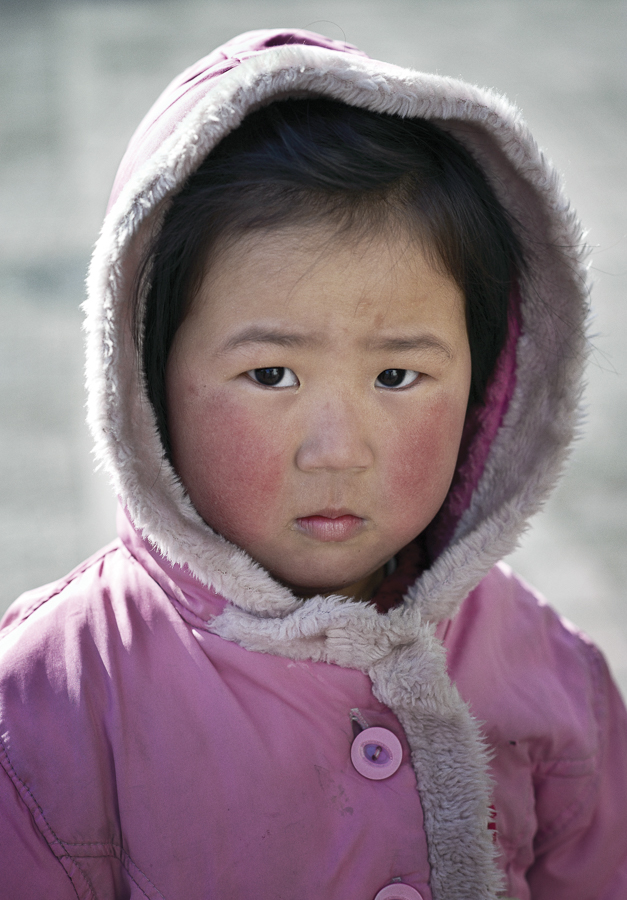 少女(北朝鮮・平壌で) ©Mark Edward Harris
少女(北朝鮮・平壌で) ©Mark Edward Harris
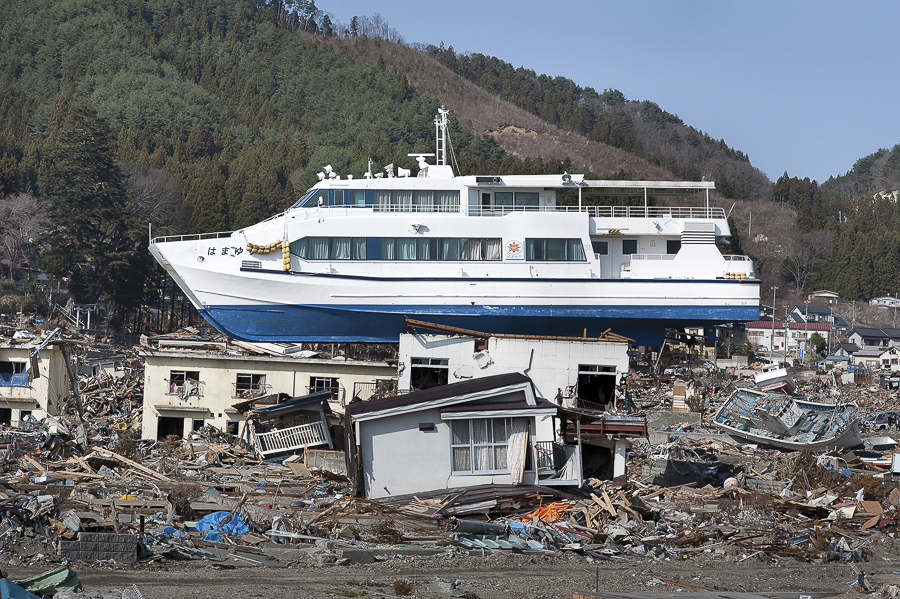 東日本大震災の津波被害 岩手県大槌町の民宿の上に 打ち上げられた釜石市の観光船「はまゆり」(2011年4月18日)。 津波のすさまじさを象徴するシーンとしてハリス氏も取材。世界に向けて発信した ©Mark Edward Harris
東日本大震災の津波被害 岩手県大槌町の民宿の上に 打ち上げられた釜石市の観光船「はまゆり」(2011年4月18日)。 津波のすさまじさを象徴するシーンとしてハリス氏も取材。世界に向けて発信した ©Mark Edward Harris
A Boat Rests Atop a Building in Tsunami Ravaged Otsuchi, Japan’s Iwate Prefecture APRIL 18, 2011 ©Mark Edward Harris
さまざまなジャンルを作品群として発表 – そこに関係性を読み取ってもらう
Q: ドキュメンタリー、広告、ポートレート、野生動物、旅行、スポーツなど、幅広い分野で活躍されていますね。多くの写真家、特に日本の写真家は同じジャンルに留まる傾向があり、その方がクライアントを確保しやすいようです。しかし、あなたは自分を限定せずに、多岐にわたるジャンルで活躍されています。仕事として成功させるために、どのような工夫をされていますか?
Q: You have been working in a wide variety of fields such as documentary, advertising, portraits, wildlife, travel stories, and sports. Often photographers have a tendency to stay in the same fields, especially in Japan, and it seems easier to keep clients in that way. But you don’t limit yourself. What are the challenges to make success as work?
MEH: 同じジャンルに留まる写真家が多いことは確かでしょう。私のようにさまざまな分野の写真を撮っていると、どのような写真家なのか戸惑うアートバイヤーもいるかもしれません。そこで私はウェブサイトやインスタグラムで写真をシリーズとして紹介し、それぞれが関連性のない個々の写真ではなく、ひとつの作品群として仕事を見てもらうことで理解してもらえるように努めています。
MEH: That’s very true. It is more difficult in certain ways because it might be confusing to some art buyers as to who I am as a photographer. I have balanced that issue out by presenting my work on my website and Instagram as series so people can see bodies of work rather than just individual photos with no relationship to each other.
この仕事を始めたころに広告業界で成功を収めたことがありますが、ある意味、出版関係の仕事にやりがいを感じています。広告の仕事の方が稼げるとしても、スタジオに詰めているよりは、ヒマラヤや北朝鮮、南極にいたいのです。私は歴史学の学士号と修士号を取得しており、ドキュメンタリーを専門としているからです。
I did have success early on in my career in advertising but I find editorial assignments more rewarding in certain ways. I would rather be in the middle of the Himalayas or North Korea or the Antarctic than in a studio even though I could make more money in advertising. My Bachelors and Masters degrees are in History with a focus on documentary work and that’s what really motivates the photography projects that I do
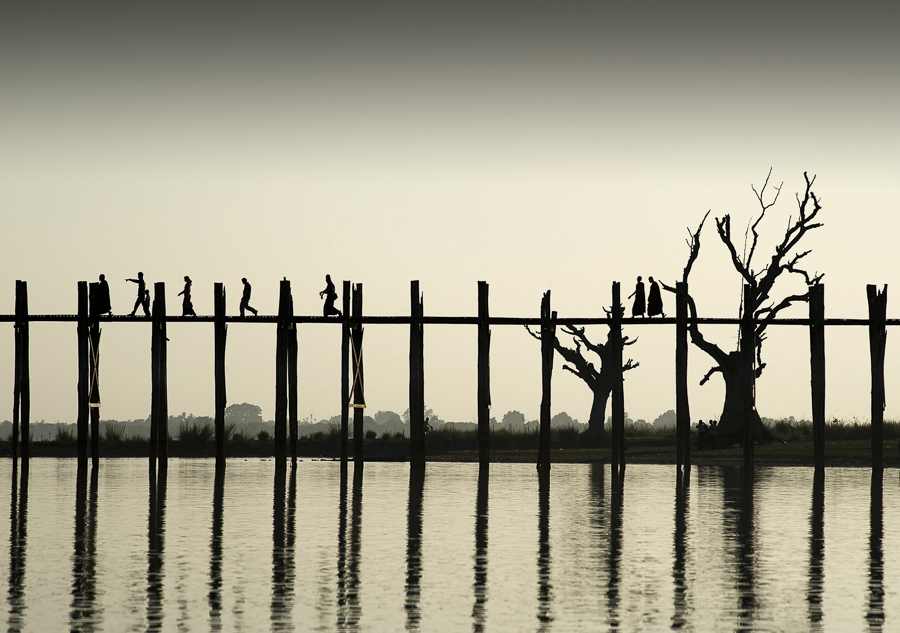 ミャンマー・マンダレーにあるウーベイン橋(2010 年 1月)。 チーク材で作られた橋としては世界最長
ミャンマー・マンダレーにあるウーベイン橋(2010 年 1月)。 チーク材で作られた橋としては世界最長
U Bein Bridge The world’s longest teak bridge,located in Mandalay in Myanmar ©Mark Edward Harris
取材テーマの見つけ方
Q: テーマはどのように見つけているのですか? また、テーマを決める際に、相互的にテーマを選ぶ場合はありますか?
Q: How do you find the themes? Is there any mutual themes when you decide them?
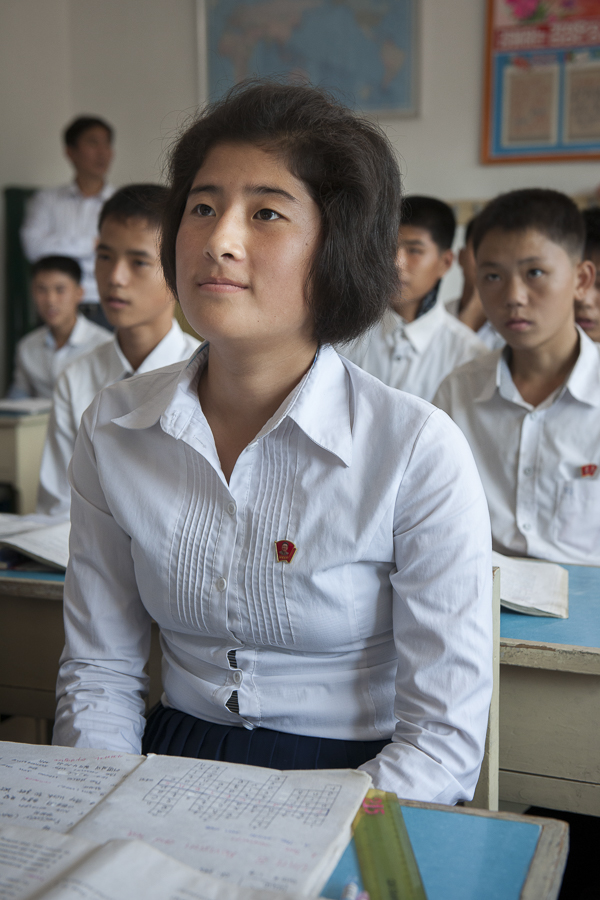 英語の授業を受ける高校生(2014年9月22日、北朝鮮・平壌で)
英語の授業を受ける高校生(2014年9月22日、北朝鮮・平壌で)
Students in a high school English class in Pyongyang, North Korea ©Mark Edward Harris
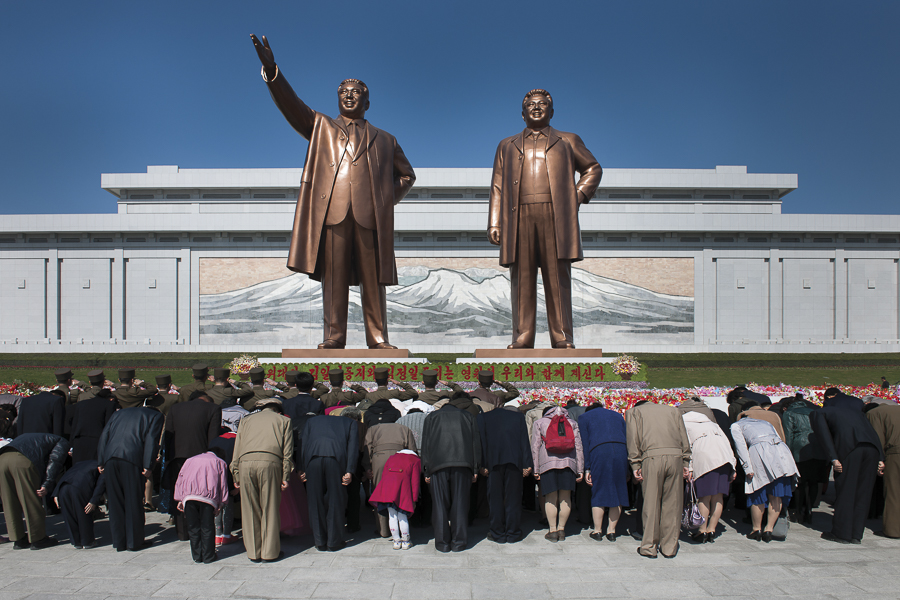 新たに公開された万寿台の金日成、金正日親子の銅像に向かって頭を下げる人々(2012年4月16日、北朝鮮・平壌で) ©Mark Edward Harris
新たに公開された万寿台の金日成、金正日親子の銅像に向かって頭を下げる人々(2012年4月16日、北朝鮮・平壌で) ©Mark Edward Harris
North Korea, Pyongyang – April 16, 2012: North Koreans bow to the newly unveiled statues of Kim Il Sung and Kim Jong Il in Pyongyang at the Mansudae Grand Monument. ©Mark Edward Harris
MEH: 歴史を学び、世界の出来事に関心があるため、地政学的な世界をよく意識し、その中からトピックを見つけて追求しています。雑誌の場合は、記念日に絡めたネタを探すことが多いですね。北朝鮮やイランと世界との関係など、地政学的な問題と絡めることもあります。私が大好きな日本の温泉のように、ある文化の興味深い一面を取り上げることもあります。また、パーム油のプランテーションによってボルネオやスマトラの森林が破壊され、残されたものを保護することができなければ、野生のオランウータンが絶滅してしまうかも知れないというような環境問題をテーマにする場合もあります。
MEH: Because of my study of history and interest in world events I’m very aware of the geopolitical world and find topics in them to pursue. For magazines, I often try to find stories that are tied in to an anniversary. Sometimes they are tied into geopolitical issues such as the relationships between the North Korea and Iran and the rest of the world.
Sometimes they are interesting facets of a culture such as Japanese hot springs
which I happen to love as well.
And sometimes it’s environmental issues such as the depletion of the forests of Borneo and Sumatra because of palm oil plantations that might lead to the extinction of orangutans in the wild if we are not able to protect what is left.
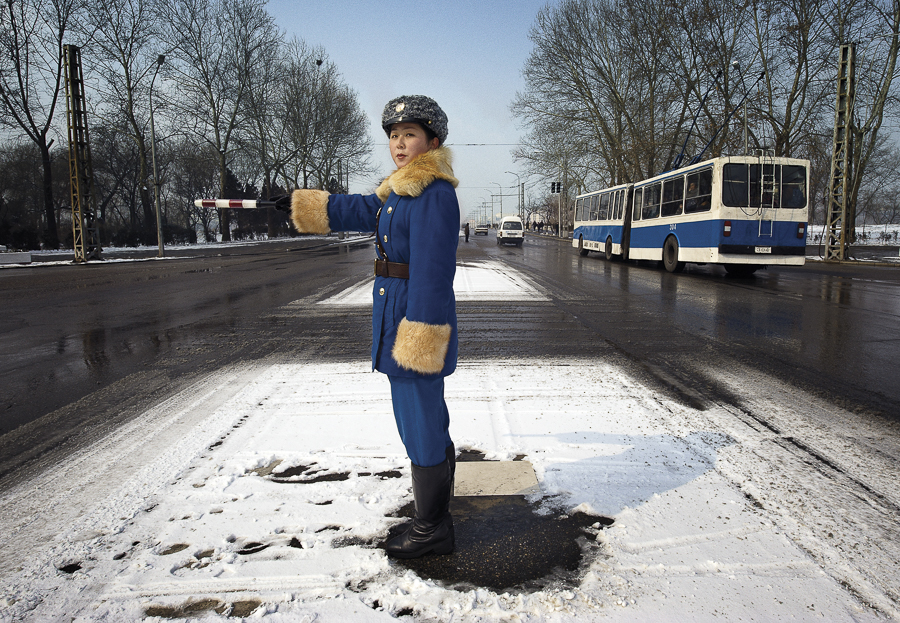 交通警官(2008年2月、北朝鮮・平壌) A traffic officer in Pyongyang, North,February,2008 ©Mark Edward Harris
交通警官(2008年2月、北朝鮮・平壌) A traffic officer in Pyongyang, North,February,2008 ©Mark Edward Harris
「The Way of the Japanese Bath」– 別府で温泉旅館の魅力に引き込まれて
Q:「The Way of the Japanese Bath」の企画を始めたきっかけやアプローチについてお聞かせください。
Q: Please let us know why did you start the project of The Way of Japanese Bath and how did you approach?
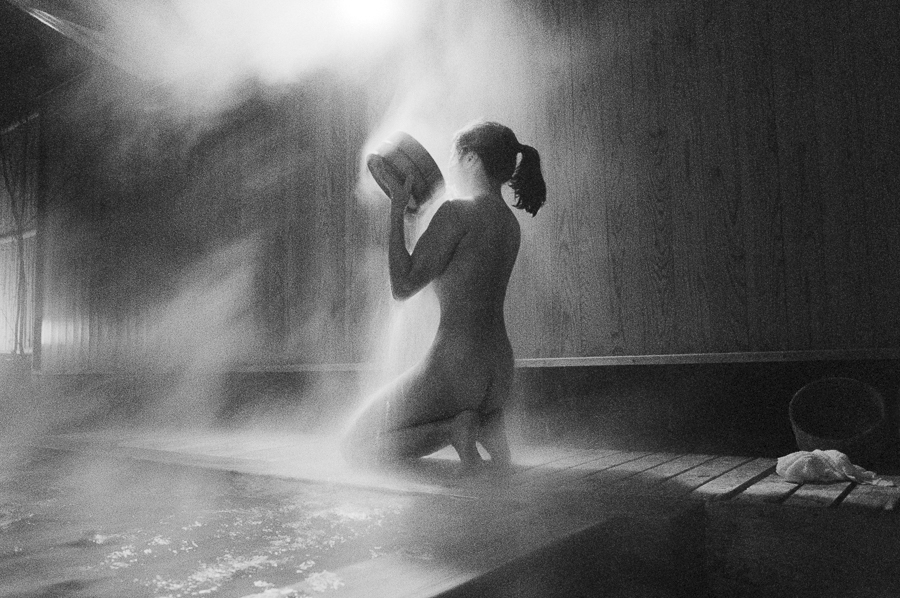 ©Mark Edward Harris
©Mark Edward Harris
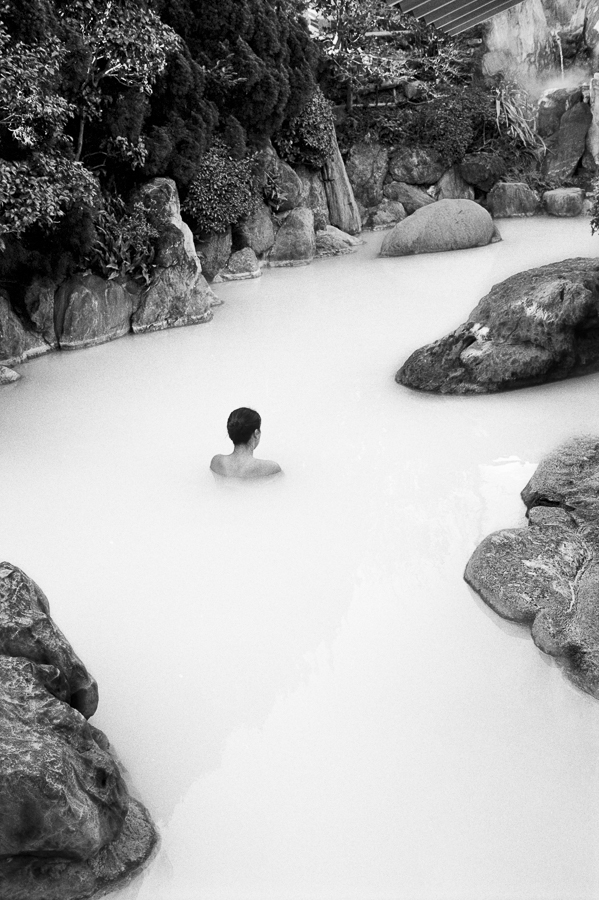 Hot spring at the Kannawa-en Ryokan (Japanese traditional inn), Beppu (on the island of Kyushu),
Hot spring at the Kannawa-en Ryokan (Japanese traditional inn), Beppu (on the island of Kyushu),
MEH:1991年、あるプロジェクトで東京に滞在していたとき、友人から別府への旅を勧められました。これまで私は日本文化において、温泉や旅館での体験がいかに重要なのかまったく知りませんでした。この2つを経験した途端、私は温泉ホリックになり、それ以来ずっと温泉ホリックです。写真の観点からは、水蒸気はシュールなシーンを作り出し、特にモノクロ写真には素晴らしい効果をもたらします。 このシリーズの最初の頃は、ニコン FM2に「Tri-x」か「TMAX 3200」か「ILFORD 3200」を装填して撮影していました。
MEH: I was in Tokyo on a project in 1991 and a friend living there suggested that we take a trip to Beppu. I had no idea about the importance of onsen and the ryokan experience in Japanese culture. As soon as I experienced both I became an ofuro-halic and have been one ever since.
From a photographic standpoint the water vapor creates a surreal scene that is
fantastic for black and white photography in particular. In the beginning of the
series I would shoot with a Nikon FM2 loaded with either Tri-x or TMAX 3200 or Ilford 3200.
作品群によるフォトエッセイで「魔法の水」を表現
MEH: このシリーズは、2000年代前半に温泉をテーマにしたプロジェクトとして、本格的にスタートしました。私はワークショップでいつも、どんなに良い写真でも、無関係な写真の束ではなく、作品群を作り、フォトエッセイを作ることが重要だと教えてきました。
このシリーズは、現在、東京でお茶の先生をしている羽根石弥佳(みか)さんなしには実現できませんでした。当時、私の妻であった彼女は、今でも素晴らしいプロデューサーです。温泉や旅館の手配をしてくれたり、モデルとして写真を撮らせてくれたりすることもありました。
私の日本語が上達するにつれて、カメラを持って温泉で何をしているのか、自分で説明できるようになりました。今でも、私は日本人の友人と一緒に日本各地の素晴らしい温泉や旅館を訪れています。拙著『The Way of the Japanese Bath』(第3版)の冒頭で述べているように、「私は今でも、この魔法の水は視覚的にも聴覚的にも無限の喜びを与えてくれる」と感じています。
MEH: The series really took shape in the early 2000s when I focused on the onsen as a project. I’ve always taught in my workshops that it’s important to build bodies of work and produce photo essays rather than just a bunch of unrelated images no matter how good they are.
I could not have done the series without Mika Haneishi who is now a tea master in Tokyo. In addition to being my wife at the time she was and still is a great producer and helped me get access to the baths and was on occasion was in some of the photos.
As my Japanese language skills progressed I have been able to explain for myself what I am doing in an onsen with a camera. I continue to travel with Japanese friends to all of these amazing places around Japan to experience baths and ryokans. As I say in the introduction to my book, The Way of the Japanese Bath, now in its 3rd edition, “I still find the magical waters an endless source of both visual and visceral pleasure.”
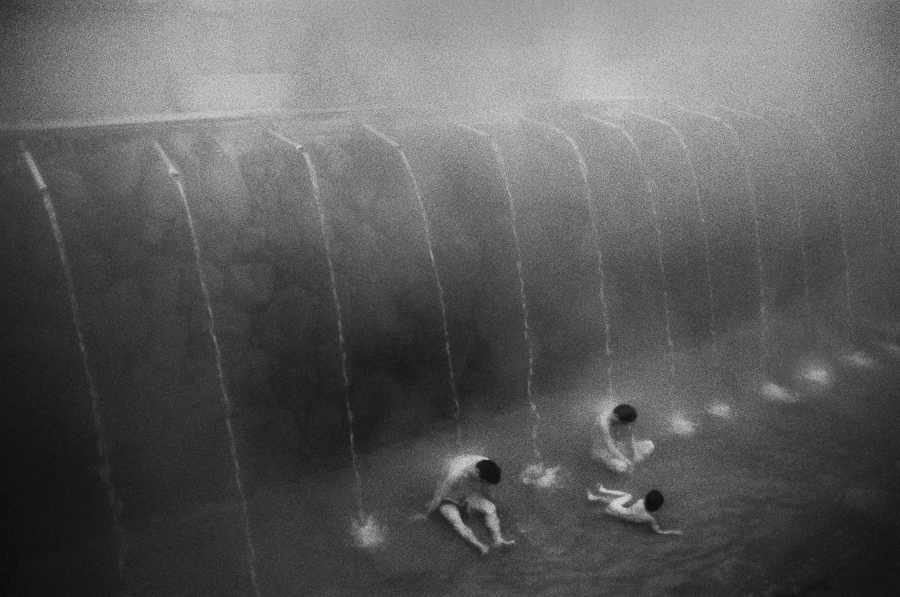 ©Mark Edward Harris
©Mark Edward Harris
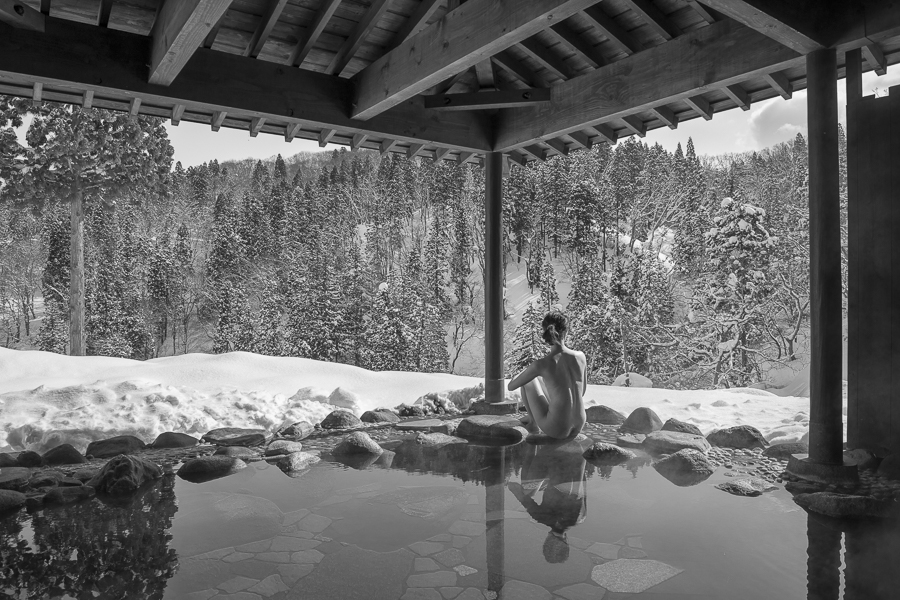 ©Mark Edward Harris
©Mark Edward Harris
アジアや日本の文化に触れたサンフランシスコとロサンゼルス – 茶道に対する意識に磨きをかけてくれた弥佳さん
Q: 日本文化に興味を持たれたきっかけは何ですか? 日本人である奥様と出会ったことと関係があるのでしょうか?
Q: Please tell us if you have any particular episodes during the shootings. What motivated you to get interested in Japanese culture? Is it something to do with the time you met your wife who is Japanese?
MEH: 私がサンフランシスコで育ち、子供の頃からアジアの文化に触れていたせいかもしれません。チャイナタウンやゴールデンゲートパークの日本庭園に行くのが大好きでした。父がロサンゼルスで就職し、こちらに引っ越してきてからは、何年も武術を習っていました。箸が上手く使えずに、食事ができなかったことは記憶にありません。
これらはすべて弥佳さんに出会う前のことですが、弥佳さんは私の日本文化に対する意識、特に茶道に対する意識に磨きをかけてくれました。彼女はロサンゼルスで松本宗静氏に師事した後、テレビ東京のエグゼクティブ・ポジションに就くために東京に戻りました。日本で茶道の勉強を続け、やがて茶道師範となり、自分の教室を開きました。私たちは、世界中の人々が茶道を知り、その技術や歴史を学ぶことができるような、英語の教育用ビデオシリーズを一緒に作り終えたところです。
MEH: It could be my growing up in San Francisco and being exposed to Asian culture as a child. I loved going to Chinatown and the Japanese Tea Garden in Golden Gate Park. I also studied martial arts for years after my father got a job in Los Angeles and we moved down here. I don’t remember a time when I couldn’t eat with chopsticks.
All this was way before I met Mika but she definitely refined my awareness of Japanese culture especially in relationship with the tea ceremony.
She studied with Mme. Sosei Matsumoto in Los Angeles before moving back to Tokyo for an executive position with TV Tokyo. In Japan Mika continued to study tea and eventually became a tea master and opened her own school. We just finished working together on an educational video series in English that will help people around the world discover the tea ceremony and learn the techniques and the history for themselves.
PORTRAITS
目は心の窓 – Eyes are the window to the soul
Q: ポートレートを撮影する際に大切にしていることは何ですか?
Q: What are the important things for you when you take portraits?
MEH: 私は力強いアイコンタクトと、二人の間に共有される静かな瞬間を探求しています。ニッコールの85mmまたは105mmを使用した「目は心の窓」タイプのポートレートでは 被写界深度を浅くし、ニッコール 24-70mm では深度をやや深くして、環境を含めたポートレート写真に仕上げます。それはドキュメンタリーや旅行写真において非常に重要で、私が最も力を入れている撮影方法です。
MEH: I look for powerful eye contact and a quiet moment shared between two people. I tend to use a shallow depth of field for my “eyes are the window to the soul” type portraits using a Nikkor 85mm or 105mm and wider focal length settings on my Nikkor 24-70mm and a little more depth of field for environmental portraiture. Environmental portraits are a very important part of documentary and travel photography which is what I most often focus on
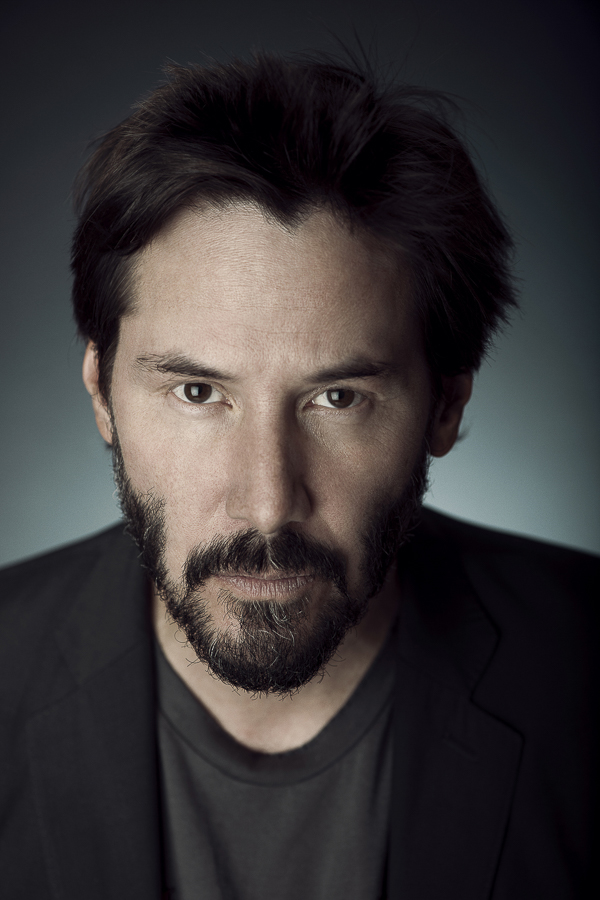 俳優のキアヌ・リーブス氏(2014年10月) ©Mark Edward Harris
俳優のキアヌ・リーブス氏(2014年10月) ©Mark Edward Harris
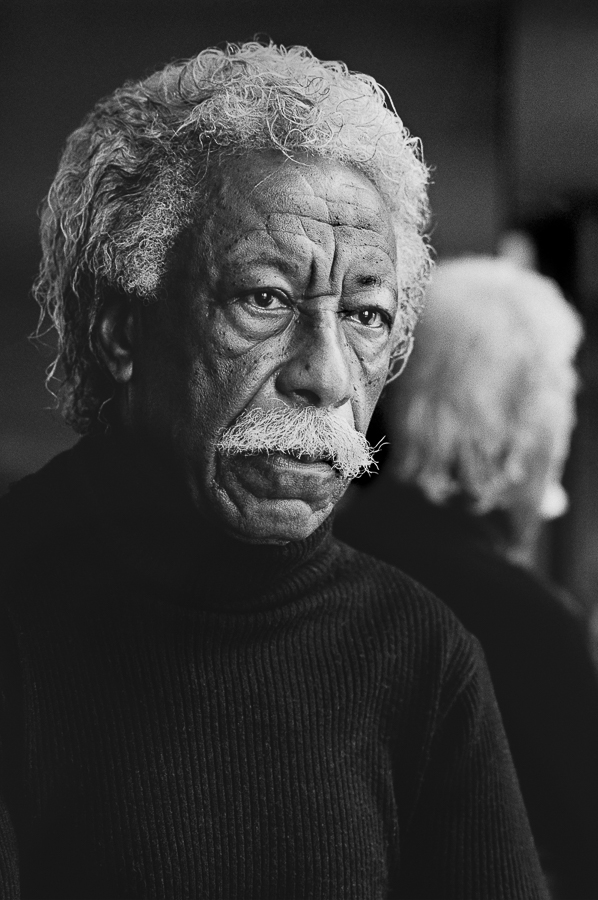 米黒人写真家でライフ紙のフォトグラファーも務めたゴードン・パークス氏(1912~2006)のポートレート ©Mark Edward Harris。
米黒人写真家でライフ紙のフォトグラファーも務めたゴードン・パークス氏(1912~2006)のポートレート ©Mark Edward Harris。
ゴードン・パークス氏 写真家、ミュージシャン、詩人、小説家、ジャーナリスト、映画監督など多彩な才能を開花させたことで知られる。黒人差別撤廃を求めマーティン・ルーサー・キング牧師が歴史的な演説を行った1963年のワシントン大行進の現場でも取材した。
Travel & Environment
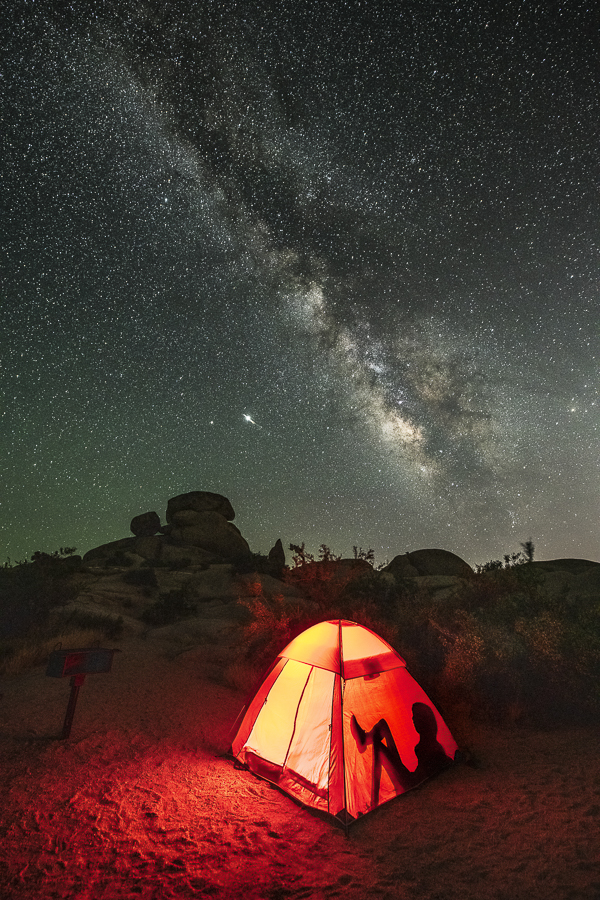 カリフォルニア州ロサンゼルス近郊にあるジョシュアツリー国立公園の星空
カリフォルニア州ロサンゼルス近郊にあるジョシュアツリー国立公園の星空
Joshua Tree ©Mark Edward Harris
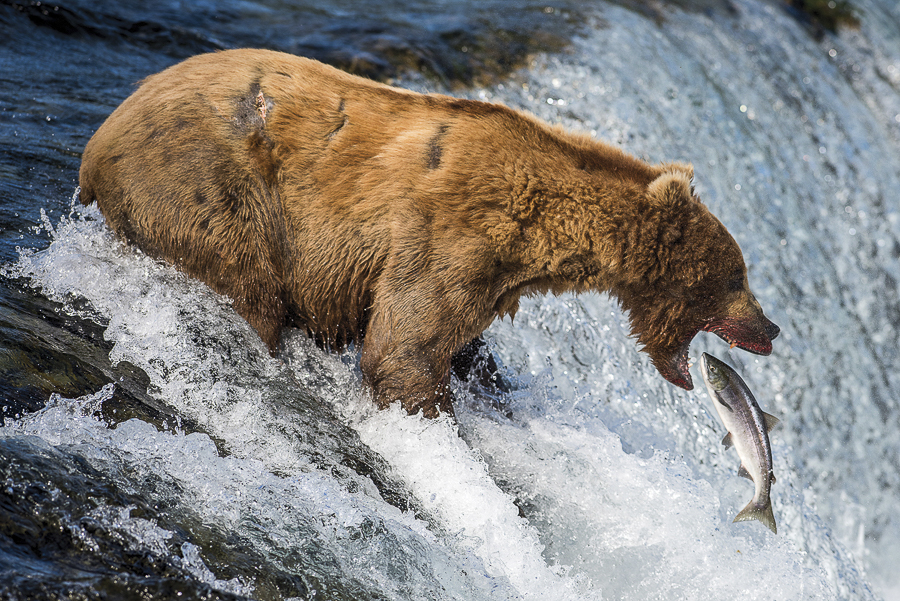 同じくカリフォルニア州ジョシュアツリー国立公園で ©Mark Edward Harris
同じくカリフォルニア州ジョシュアツリー国立公園で ©Mark Edward Harris
「People of the Forest」- オランウータンの目の奥にある感性
Q:「People of the Forest」というプロジェクトでは、オランウータンを人間のポートレートのように撮影されていますね。このプロジェクトのコンセプトについて教えてください。
Q: Regarding your project “People of the Forest”, you took photos of orangutans like the portraits of people. Will you explain the concept of the project?
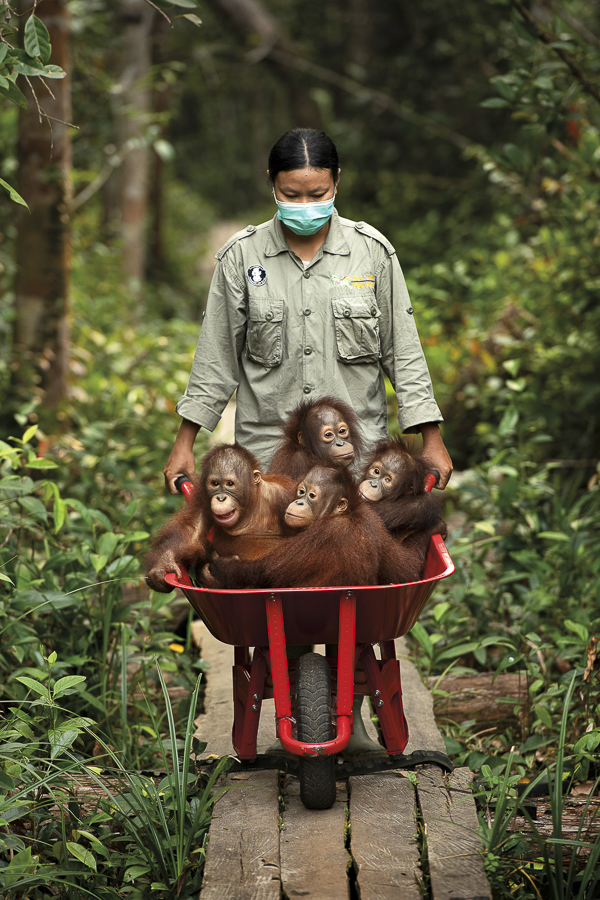 孤児になってしまったオランウータンたちが、森の学校から帰ってきた(ボルネオ島ニャル・メンテン) ©Mark Edward Harris
孤児になってしまったオランウータンたちが、森の学校から帰ってきた(ボルネオ島ニャル・メンテン) ©Mark Edward Harris
Orphaned orangutans on their way back from Forest School at Nyaru Menteng, Borneo. ©Mark Edward Harris
MEH: 私たち人間も、オランウータンやゴリラ、チンパンジー、ボノボと同じ類人猿で、DNAの違いはごくわずかです。オランウータンの場合、約96.4パーセントのDNAが人間と同じとされています。私が注目したいのはオランウータンの目の奥に、人間と同じような感性があることです。私の写真にはそれが映し出されていると思っています。
ボルネオ島とスマトラ島の2カ所でしか生息していない野生のオランウータンは、人間が彼らの生活圏に侵入したことにより、絶滅の危機に瀕しています。その主な原因はパーム油のプランテーションです。手遅れになる前に持続可能な解決策を見出すことが、彼らの生存にとって不可欠なのです。私のプロジェクトが、この重要な問題に注意を喚起することを願っています。
MEH: Humans along with orangutans, gorillas, chimpanzees and bonobos are all great apes and there is only a very small amount of DNA difference between us. In the case of orangutans we share around 96.4 percent of the same DNA. There is a sentient being behind the eyes that I am focusing on and I think my photos reflect this.
Orangutans in the wild in the only two places they still live freely, Borneo and Sumatra, are in danger of becoming extinct because of human incursions into their habits. This is mainly due to palm oil plantations. It is vital to their survival that sustainable solutions be found before it’s too late. I hope my project helps bring attention to this important issue.
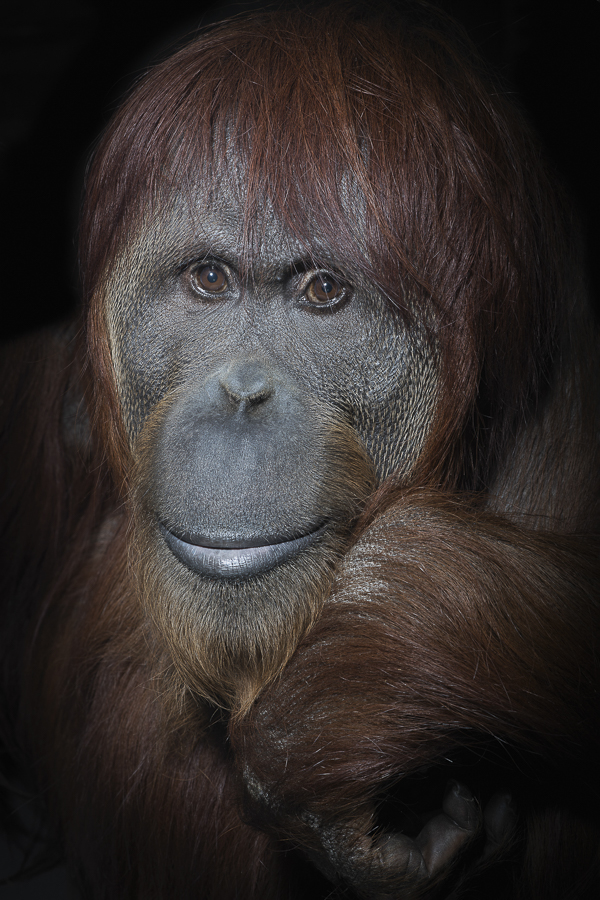 ©Mark Edward Harris
©Mark Edward Harris
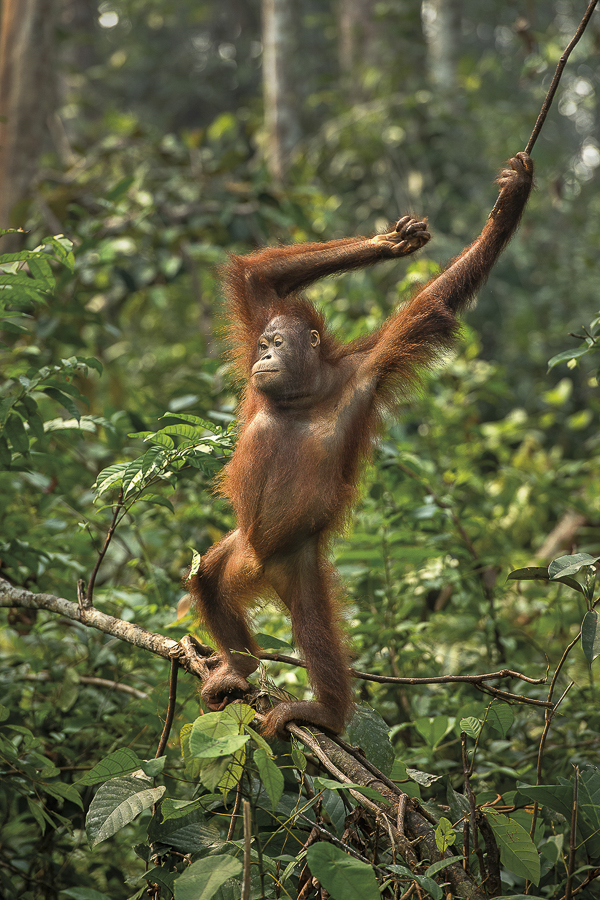 ©Mark Edward Harris
©Mark Edward Harris
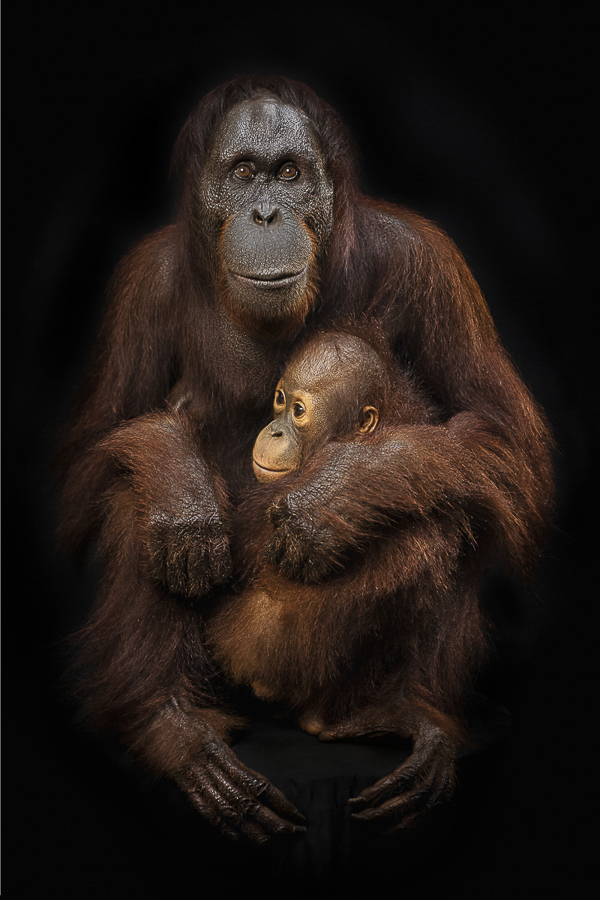 ©Mark Edward Harris
©Mark Edward Harris
「一つの扉が閉まれば、別の扉が開く」
Q: COVID-19の期間中は、どのように過ごされていましたか?このパンデミックによって、写真家としての活動や考え方に変化はありましたか?もしそうなら、どのように変化したでしょうか?
Q: How did you spend time during Covid-19? Did this pandemic change your activity as a photographer and thoughts? If yes, in what way?
MEH: 私はいつも「一つの扉が閉まれば、別の扉が開く」という哲学を持って生きてきました。パンデミックによって多くのドアが閉ざされ、私が行っていた実習ワークショップはすべて取り止めとなり、国内外のほとんどの撮影もキャンセルされたため、経済的に大きな影響がありましたが、この機会に私は予定よりも早く「People of the Forest」の制作と出版を進めることができました。
その結果、オーストラリアの Head on Photo Festival で個展を開催したり、数々の賞を 受賞したりと、新しい扉を開くことができました。また、スペインや他の国での展示も決まり始めています。
地元のロサンゼルスでは、パンデミックによって観光客がいなくなったハリウッドをテーマにした新シリーズ「Naked Hollywood」に取り組み始めています。
MEH: I’ve always lived by the philosophy that when one door closes another one opens. A lot of doors closed because of the pandemic and all my in person workshops were canceled as well as most international and domestic photo assignments so there was a big economic impact but I took the opportunity to move ahead faster than planned with the production and release of The People of the Forest.
That turned out to open a lot of new doors including a solo exhibition at the Head On Photo Festival in Australia and a number of awards. We also have exhibitions in Spain and other countries starting to get lined up.
While in LA I’ve been working on a new series, Naked Hollywood, about that area of the city that was stripped of tourists because of the pandemic.
南極のフォトエッセイに向けて
Q: 今後取り組んでみたいテーマは何ですか? お答えできる範囲で教えてください。
Q: What’s theme that you would like to work on in the future? Please let us know if you can tell.
MEH:「The Way of the Japanese Bath」シリーズは第4版まで、「People of the Forest」は第2版まで続ける予定です。また、北朝鮮には10回ほど行っていますが、引き続きドキュメンタリーを撮り続けたいと思っています。南極は私にとって新しい地域ですが、Antarctica21という素晴らしい会社のサポートで撮影に行き、近い将来、南極のフォトエッセイを発表する予定です。
MEH: I will continue my The Way of the Japanese Bath series for an eventual 4th edition of the book and a 2nd edition of The People of the Forest. I hope to get back to North Korea again as well to continue my documentary work there. I’ve been there 10 times so far. Antarctica is a new area for me and I’m working with a fantastic company, Antarctica21 to get me there and back so there will be photo essays coming out about that experience in the near future.
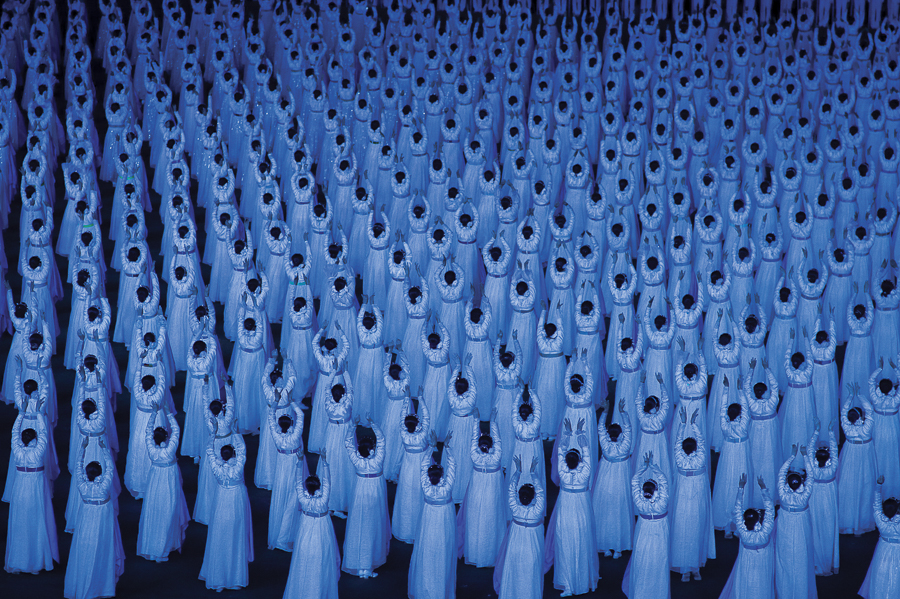 北朝鮮のアリラン祭で披露されるマスゲーム(2010年) ©Mark Edward Harris
北朝鮮のアリラン祭で披露されるマスゲーム(2010年) ©Mark Edward Harris
Arirang Mass Games,2010 ©Mark Edward Harris
マーク・エドワード・ハリス
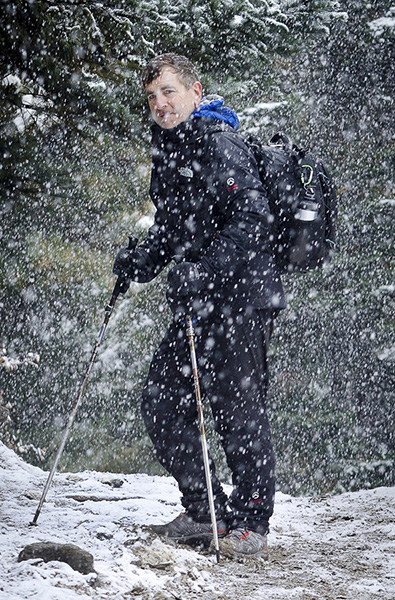
カリフォルニア州立大学ロサンゼルス校(CAL STATE LA)を写真/ドキュメンタリー史の修士号を取得して卒業。マーブ・グリフィン・ショーや様々なテレビ局、映画会社のスチール写真撮影を担当し、プロとしてのキャリアをスタートさせた。1986年に番組が終了すると、4ヶ月間の太平洋横断と東南アジア、中国、日本への旅に出発。この旅で撮影された写真でドキュメンタリー写真家として注目を集めるようになった。
その後、7大陸100カ国以上で撮影取材。作品は、Vanity Fair、LIFE、The New York Times、The Washington Post、Time Magazine、GEO、Newsweek、Conde Nast Traveler、National Geographic Traveler、Hemispheres、AFAR、Wallpaper、Vogue、Architectural Digest、The Los Angeles Times Magazine、The London Sunday Times Travel Magazineなどの雑誌、主要写真誌、機内誌に掲載され、CLIO、ACE、Impact DOCS Award of Excellence、Aurora Gold、IPAなど、数々の賞を受賞している。
主な著書は「Faces of the Twentieth Century: Master Photographers and Their Work」、「The Way of the Japanese Bath」、「Inside North Korea」、「North Korea」、「South Korea」「Inside Iran」、「The Travel Photo Essay: Describing A Journey Through Images 」などで、最新作にオランウータンの写真集「The People of the Forest」がある。
ハリス氏は2022年2月8日現在、新しく導入したNikon Z9で北京2022冬季オリンピックを取材中です。
・Instagram :@MarkEdwardHarrisPhoto
・Website:http://www.MarkEdwardHarris.com
After graduating from California State University, Los Angeles with a Master of Arts Degree in Pictorial/Documentary History, Mark Edward Harris started his professional photography career doing the stills for the Merv Griffin Show and various television and movie companies. When the show ended in 1986 he set off on a four-month trek across the Pacific and throughout Southeast Asia, China and Japan. The images created on that trip brought attention to his documentary photography.
Assignments have since taken Harris to more than 100 countries and all seven continents. His editorial work has appeared in publications such as Vanity Fair, LIFE, The New York Times, The Washington Post, Time Magazine, GEO, Newsweek, Conde Nast Traveler, National Geographic Traveler, Hemispheres, AFAR, Wallpaper, Vogue, Architectural Digest, The Los Angeles Times Magazine, and The London Sunday Times Travel Magazine as well as all the major photography and in-flight magazines. Among his numerous accolades are CLIO, ACE, Impact DOCS Award of Excellence, Aurora Gold, and IPA awards.
His books include Faces of the Twentieth Century: Master Photographers and Their Work, The Way of the Japanese Bath, Wanderlust, North Korea, South Korea, Inside Iran, The Travel Photo Essay: Describing A Journey Through Images and his latest, The People of the Forest, a book about orangutans.
As of Feb.8 2022, Mr.Harris is covering the Beijing 2022 Olympic Winter Games with his new Nikon Z9.
・Instagram :@MarkEdwardHarrisPhoto
・Website:http://www.MarkEdwardHarris.com

